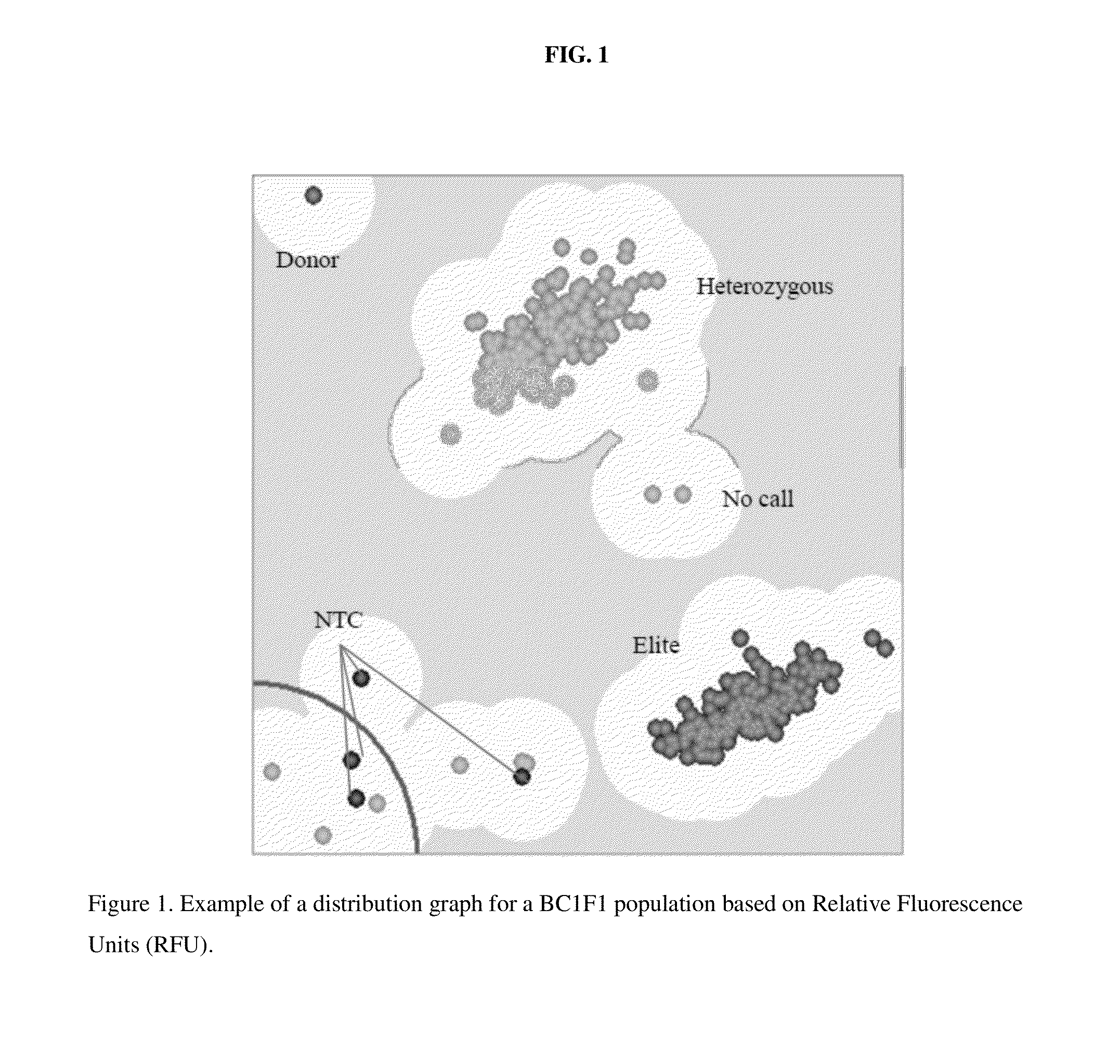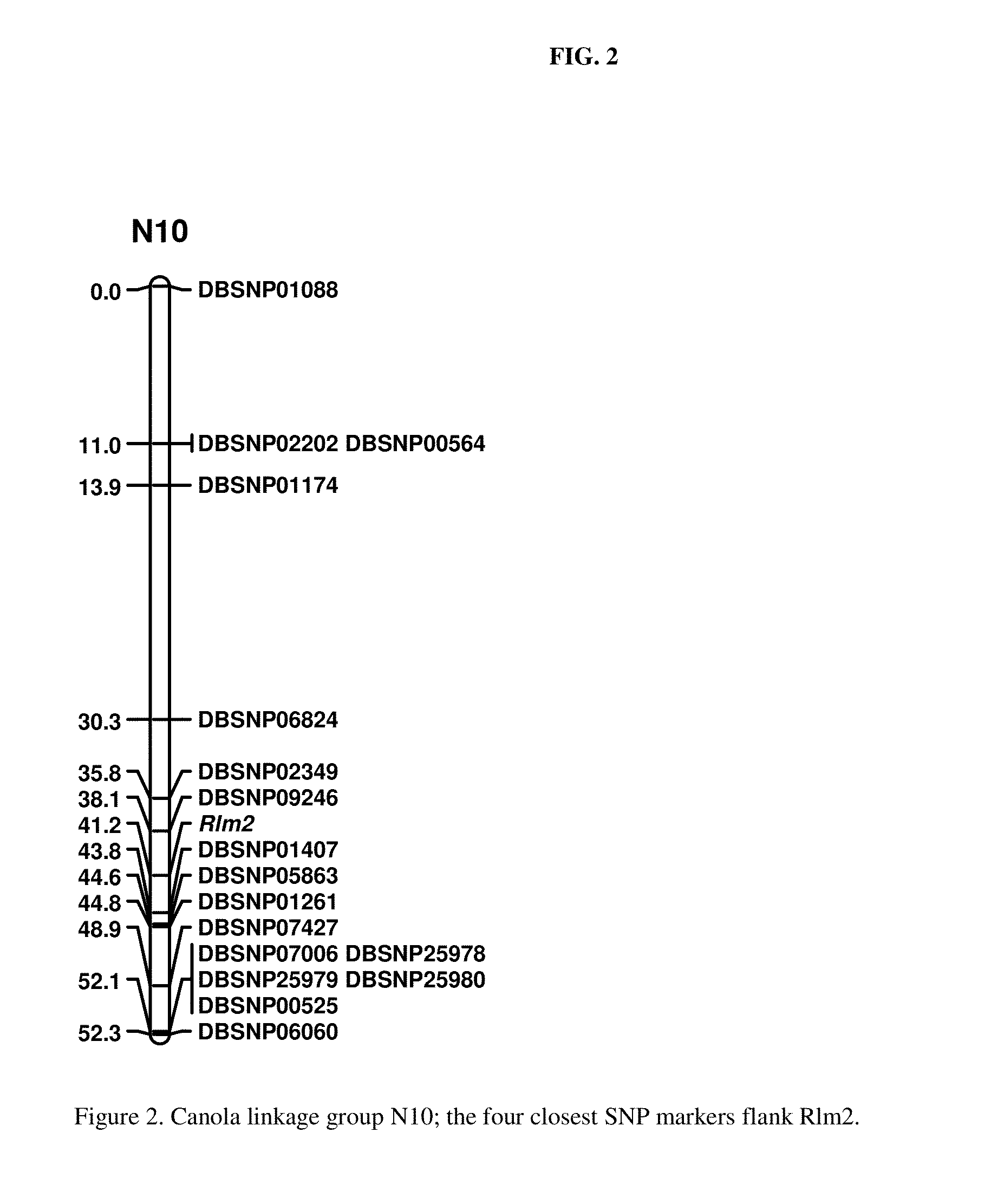Molecular markers for blackleg resistance gene rlm2 in brassica napus and methods of using the same
a technology of blackleg resistance and molecular markers, which is applied in the field of canola plants, can solve the problems of significant yield loss, plant is susceptible to blackleg infection, dry rot or canker at the base of the stem, etc., and achieves superior utility in marker-assisted selection and facilitate marker-assisted selection
- Summary
- Abstract
- Description
- Claims
- Application Information
AI Technical Summary
Benefits of technology
Problems solved by technology
Method used
Image
Examples
example 1
Plant material and DNA extraction
[0193]The Nex845CL / NT152344 / / Nex845CL population, consisting of 708 BC1F1 progeny, was used for fine mapping Rlm2. Nex845CL, a Dow AgroSciences (DAS) spring canola line with the Omega-9 oil profile, is the recurrent parent. NT152344, a spring canola line, is the Rlm2 donor parent.
[0194]DNA was extracted using the MagAttract DNA extraction method (Qiagen, Valencia, Calif.) using the Biocel 1800 (Agilent Technologies, Santa Clara, Calif.). DNA was quantified using the Nanodrop 8000 Spectrophotometer (Thermo Scientific, Rockford, Ill.) per manufacturer's instructions.
example 2
Phenotyping the Mapping Population
Plant Grow Out
[0195]Seeds were sown in soil in a 36-well insert flats in growth chambers. Single plant was inoculated on 4 lobes of the cotyledon. Normal plant growing conditions were maintained (16:8 light / dark photoperiods, 19° C. at day time and 16° C. at night). Watering and fertilization were applied as normal.
[0196]Inoculation was done at 10 days after planting when cotyledons were fully expanded. Each lobe of the cotyledon was wounded using a tissue teeth forceps. Ten microliters (μl) of Leptosphaeria maculans (L. maculans) pycnidiospore suspension in H2O at a concentration of 2×107spores / m1 using a repeating pipette was dropped on each lobe. Four droplets on two cotyledons were dropped on a single plant. In cases where a single plant was used from segregating populations, for example backcross or F2 populations, 4 ratings of one plant were treated as replicates. Inoculated cotyledons were kept at room temperature for 6-8 hours bef...
example 3
The KBioscience Competitive Allele-Specific PCR Genotyping System (KASPar™)
[0200]The KASPar™ genotyping system is comprised of two components (1) the SNP-specific assay (a combination of three unlabelled primers), and (2) the universal Reaction Mix, supplied at 2× concentration, and containing Taq polymerase enzyme, the passive reference dye, ROX, 50 mM MgCl2, and DMSO. The three primers, allele-specific 1 (A1), allele-specific 2 (A2), and common (C1), or reverse, were designed using the assay design algorithm of the workflow manager, Kraken (KBiosciences, Hoddesdon, Hertfordshire, UK).
[0201]An Assay Mix of the 3 primers was made, consisting of 12 micromolar (μM) each of A1 and A2 and 30 μM of C1. The universal Reaction Mix was diluted to 1× and an additional amount of MgCl2 is added so that the final MgCl2 concentration of Reaction Mix at 1× concentration is 1.8 millimolar (mM). DNA was dispensed into 384 well PCR plates at a concentration of 1-5 ng / μ1 per well and was dried down i...
PUM
| Property | Measurement | Unit |
|---|---|---|
| time | aaaaa | aaaaa |
| temperature | aaaaa | aaaaa |
| blackleg resistance | aaaaa | aaaaa |
Abstract
Description
Claims
Application Information
 Login to View More
Login to View More - R&D
- Intellectual Property
- Life Sciences
- Materials
- Tech Scout
- Unparalleled Data Quality
- Higher Quality Content
- 60% Fewer Hallucinations
Browse by: Latest US Patents, China's latest patents, Technical Efficacy Thesaurus, Application Domain, Technology Topic, Popular Technical Reports.
© 2025 PatSnap. All rights reserved.Legal|Privacy policy|Modern Slavery Act Transparency Statement|Sitemap|About US| Contact US: help@patsnap.com



